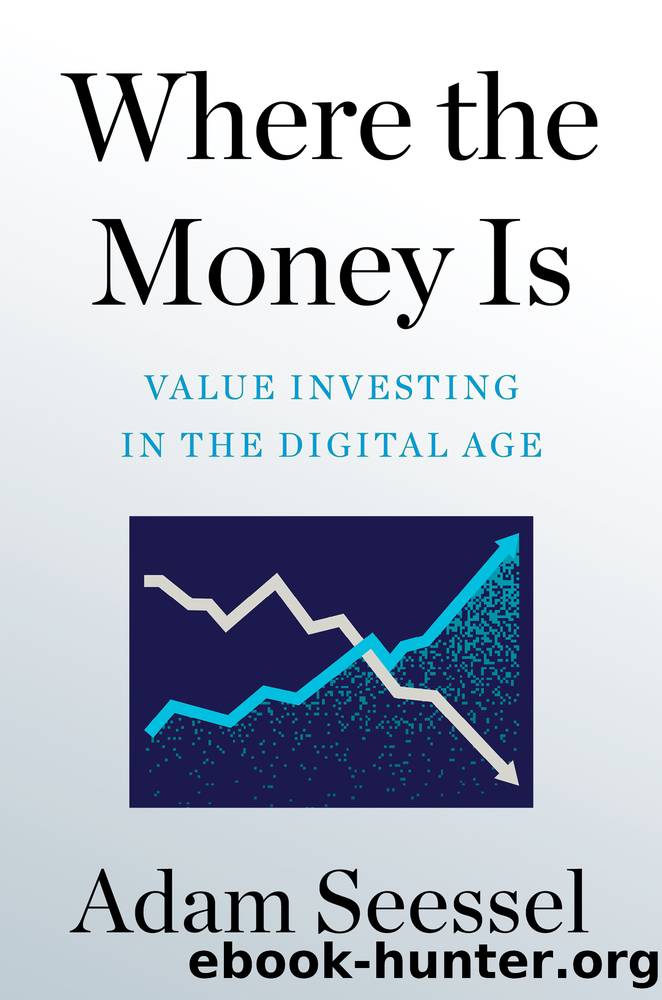Where the Money Is by Adam Seessel

Author:Adam Seessel
Language: eng
Format: epub
Publisher: Avid Reader Press / Simon & Schuster
Published: 2022-05-24T00:00:00+00:00
TOOLS TO KEEP BUT MODIFY
Like Buffettâs Value 2.0, Value 3.0 uses cash earnings as its valuation north star. What John Burr Williams wrote in The Theory of Investment Value more than eighty years ago remains true: the value of any business is the sum of all its future free cash flows, discounted back to the present at an appropriate interest rate. As a practical matter, however, itâs impossible and therefore fruitless to forecast such cash flows beyond a few years. The future is unpredictable and, outside a certain time horizon, completely unknowable. Thatâs why the price/earnings ratio based on current earnings has become such a popular shorthand: Iâm paying $X for $Y in earnings that I can see today. Everything else is unclear.
What is clear, however, is that the P/E ratio based on current earnings has not captured the value that tech has created. If it had, Value 2.0 investors would have done exceedingly well with Amazon, Alphabet, and the rest over the last two decades. Instead, most value managers have underperformed the market rather badly, sniffing all the way at tech stocks as âexpensive.â Because weâve not adapted our methods, weâve missed out on nearly a generation of wealth creation.
After my own period of underperformance in the mid-2010s, I broke the P/E tool down, trying to figure out why it wasnât working and how I could modify it so that it would work again. In the end, I have altered the P/E construct in two material ways.
First, instead of looking only at this yearâs or next yearâs earnings, I look at earnings several years out. This exercise is not based on some wild-eyed dream of âthe future.â I donât propose to project out a decade, or even five years: nobody knows whatâs going to happen that far out. On the other hand, certain digital companies have such strong competitive moats and are so early in their growth trajectory that itâs reasonable to forecast what their business will look like in a few years. What is the likelihood that Alphabet will grow its business over the next thirty-six months? What is the likelihood that Airbnb, DocuSign, Adobe, and dozens of other digital enterprises will continue to penetrate their markets? I think most reasonable people would agree that itâs probable such companies will grow over the next few years.
The second adjustment I make is more radical and more dramatic. It involves the concept of earnings power, which I introduced in chapter 4 when I compared Campbellâs to Intuit. While Campbellâs business is mature and therefore in harvest mode, Intuitâs is not. Faced with slow growth, Campbellâs is rightfully milking its business for every dollar of current earnings that it can. Intuit, on the other hand, is deploying billions into sales and marketing and research and development to grow future earnings. This spending is anchored in sound business logic, but it has the effect of depressing Intuitâs current reported profits.
Such aggressive spending behavior is common among tech companies. Facebook, Alphabet, Amazon, Apple,
Download
This site does not store any files on its server. We only index and link to content provided by other sites. Please contact the content providers to delete copyright contents if any and email us, we'll remove relevant links or contents immediately.
| Analysis & Strategy | Bonds |
| Commodities | Derivatives |
| Futures | Introduction |
| Mutual Funds | Online Trading |
| Options | Portfolio Management |
| Real Estate | Stocks |
Rich Dad Poor Dad by Robert T. Kiyosaki(6502)
Pioneering Portfolio Management by David F. Swensen(6253)
How To Win Friends and Influence People by Dale Carnegie(4469)
The Money Culture by Michael Lewis(4124)
The Dhandho Investor by Mohnish Pabrai(3721)
The Wisdom of Finance by Mihir Desai(3691)
Liar's Poker by Michael Lewis(3410)
Fooled by Randomness: The Hidden Role of Chance in Life and in the Markets by Nassim Nicholas Taleb(3076)
The ONE Thing by Gary Keller(3030)
The Intelligent Investor by Benjamin Graham Jason Zweig(3010)
Mastering Bitcoin: Programming the Open Blockchain by Andreas M. Antonopoulos(3005)
Rich Dad Poor Dad: What The Rich Teach Their Kids About Money - That The Poor And Middle Class Do Not! by Robert T. Kiyosaki(2928)
How to Day Trade for a Living: Tools, Tactics, Money Management, Discipline and Trading Psychology by Andrew Aziz(2923)
Investing For Dummies by Eric Tyson(2920)
How to Win Friends and Influence People by Dale Carnegie(2880)
The Psychology of Money by Morgan Housel(2773)
Market Wizards by Jack D. Schwager(2667)
Zero Hour by Harry S. Dent Jr. & Andrew Pancholi(2628)
How to Pay Zero Taxes, 2018 by Jeff A. Schnepper(2621)
